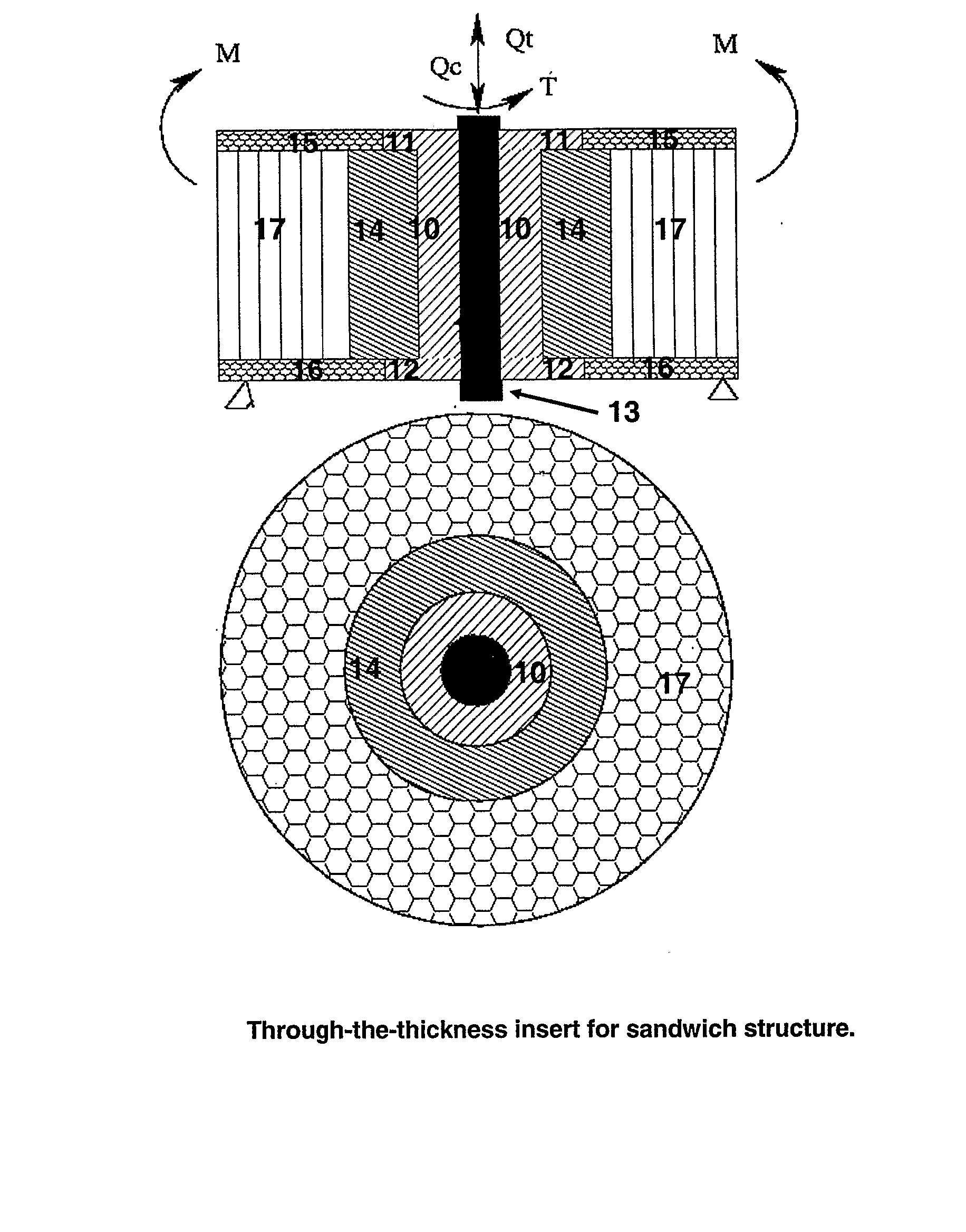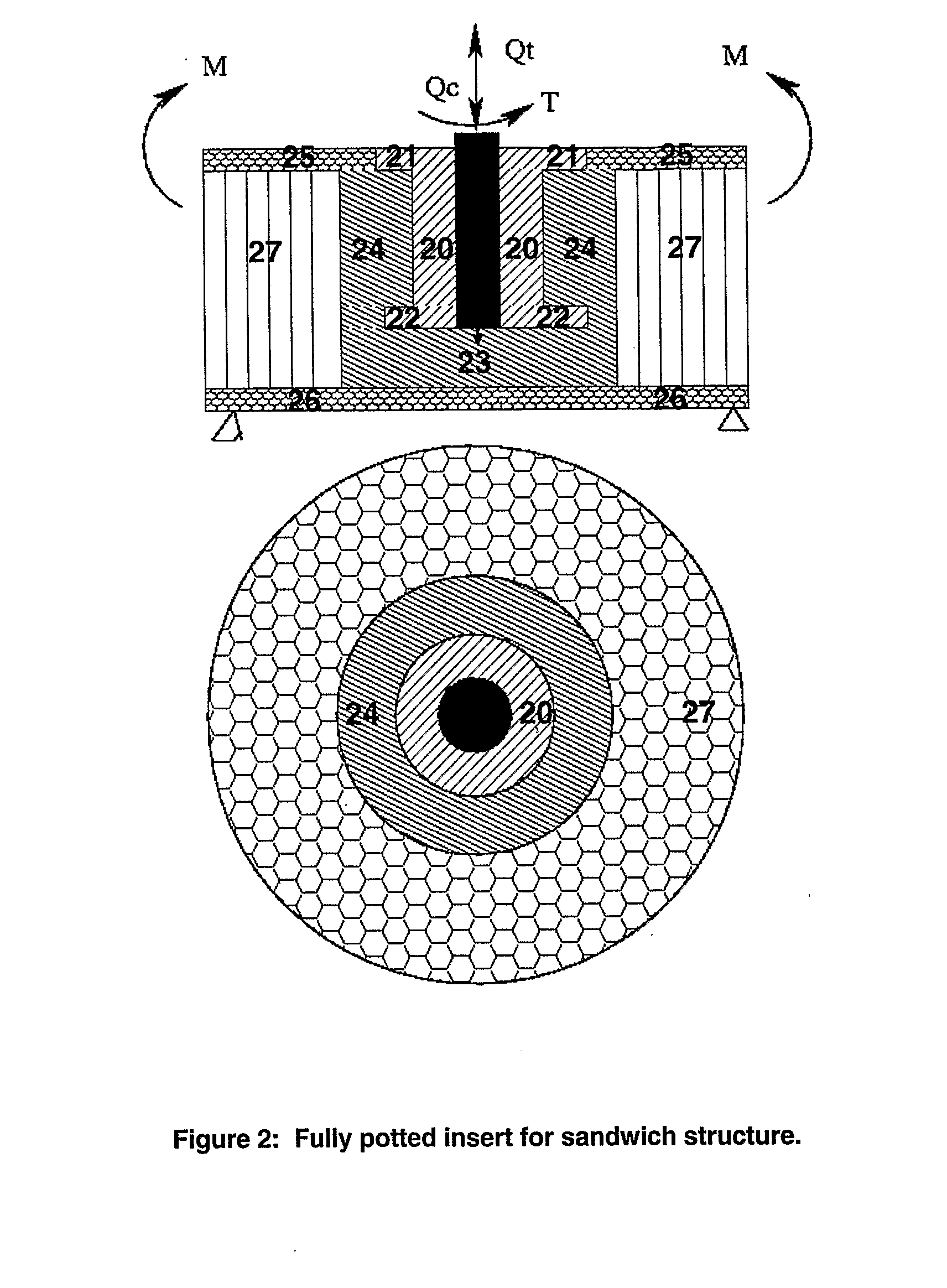Novel Strength Enhancing Insert Assemblies
a technology of insert assembly and insert, which is applied in the direction of sheet joining, branching pipes, fastening means, etc., can solve the problems of high stress concentration at the interface between insert and potting material, unsatisfactory reduction of specific strength, and inability to address the problem of minimization of insert assembly weight and a means to increase specific strength, so as to achieve high specific strength and reduce stress concentration
- Summary
- Abstract
- Description
- Claims
- Application Information
AI Technical Summary
Benefits of technology
Problems solved by technology
Method used
Image
Examples
example 1
Experimental Studies
[0135] Fabrication of Through-the-Thickness Insert Assembly
[0136] The insert assembly comprises of six constituents. They are: insert, potting material, foam core, lower face-plate, upper face-plate and the attachment. Lower face-plate and the upper face-plate are made of woven fabric E glass and epoxy resin using matched-die molding technique. The core is made of polyurethane foam. The attachment is made of mild steel. The material used for composite inserts is glass. The potting material is epoxy resin. Three insert assemblies were constructed using the above with aluminum, 2D woven composite and 3D woven composite as insert materials. [0137] Measurement of load, displacements and failure initiation [0138] The insert assembly was placed on a support ring and then located on Hounsfield Test Equipment—450 KS, 50 KN UTM. [0139] Compressive load was applied through the attachment on to the insert assembly. [0140] The displacement of the attachment, lower face-pla...
example 2
Comparison of Through-the-Thickness Inserts of Present Invention with Inserts of Prior Art
[0148] Using the method of the present invention, compressive load at failure initiation, failure function and specific strength of inserts are mapped for the prior art disclosed in U.S. Pat. No. 50,532,285 (corrugated aluminum insert) and for the insert (3D woven composite insert) of the present invention with the same geometry as used for the prior art (R=30 mm). The results are given in FIG. 10 and Table 5. Further, the geometry of the insert of the present invention was modified (R=10 mm) to reduce the insert assembly weight. With such a modified configuration, compressive load at failure initiation, failure function and specific strength of inserts are mapped. From FIG. 10 and Table 5, it is established that the inserts of the present invention are having higher specific strength compared to the insert of prior art.
TABLE 5Specific strength of through-the-thickness inserts with corrugate...
example 3
Analytical Studies with Different Insert Materials
[0149] Using the experimentally validated method for mapping of stresses, displacements and failure initiation, the results for aluminum, 2D woven composite, 3D thermoelastic isotropic woven composite, 3D woven composite, 3D woven composite with multiple inserts and 3D functionally gradient woven composite are obtained for the geometrical configuration of the insert assembly as given in Table 6. Material properties of the insert assembly are presented in Tables 7 and 8.
[0150] Maximum displacement, maximum normal stress and maximum shear stress corresponding to maximum compressive load at failure initiation are presented in Table 9. Specific strength of insert for different materials is also presented in Table 9. Failure function as a function of compressive load for different insert materials is presented in FIG. 11.
[0151] Percentage increase in specific strength of insert and percentage decrease in mass of insert for the composit...
PUM
 Login to View More
Login to View More Abstract
Description
Claims
Application Information
 Login to View More
Login to View More - R&D
- Intellectual Property
- Life Sciences
- Materials
- Tech Scout
- Unparalleled Data Quality
- Higher Quality Content
- 60% Fewer Hallucinations
Browse by: Latest US Patents, China's latest patents, Technical Efficacy Thesaurus, Application Domain, Technology Topic, Popular Technical Reports.
© 2025 PatSnap. All rights reserved.Legal|Privacy policy|Modern Slavery Act Transparency Statement|Sitemap|About US| Contact US: help@patsnap.com



